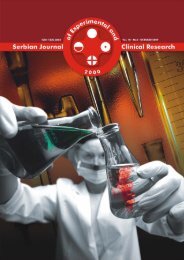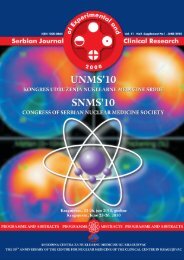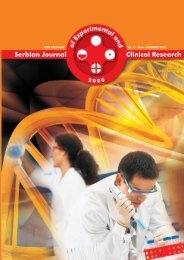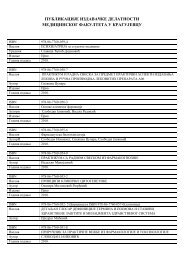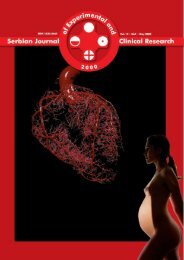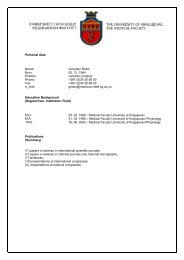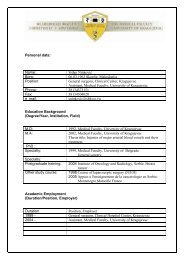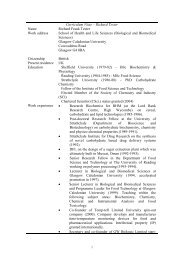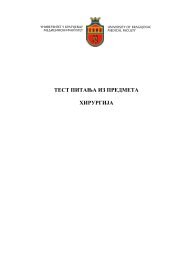neurotoxicity and mechanisms of induced hyperexcitability
neurotoxicity and mechanisms of induced hyperexcitability
neurotoxicity and mechanisms of induced hyperexcitability
Create successful ePaper yourself
Turn your PDF publications into a flip-book with our unique Google optimized e-Paper software.
INTRODUCTIONCardiovascular diseases present a leading cause <strong>of</strong>death in patients treated with haemodialysis [1, 2]. Therate <strong>of</strong> cardiovascular mortality in this population is approximately9% on an annual basis, with left ventricularhypertrophy, ischemic heart diseases <strong>and</strong> heart failure havingthe highest rates <strong>of</strong> mortality [1, 2].METHODSFor this study, the Medline database was used. The followingkey words were used for searching: risk factors, leftventricular hypertrophy, echocardiography, <strong>and</strong> haemodialysis.About 40.000 references were found dealing withthese types <strong>of</strong> problems. Systematic review articles <strong>and</strong>well-controlled clinical studies were singled out. Editor’sletters <strong>and</strong> uncontrolled clinical studies were not used.Systematic review articles were used <strong>and</strong> analysed by theNational Kidney Foundation Kidney Disease OutcomeQuality Initiative (NKF KDOQI), which confirmed the validity<strong>and</strong> quality <strong>of</strong> the selected references.RE SULTSAetiopathogenesis <strong>of</strong> left ventricle hypertrophyThe most important risk factors <strong>of</strong> left ventricle hypertrophyin haemodialysis patients are hypertension, arteriosclerosis,adult aortic stenosis, anaemia, increased blood flowthrough the vascular access for haemodialysis <strong>and</strong> increasedvolume <strong>of</strong> extracellular fluid [3, 4]. Pressure overloads <strong>of</strong> theleft ventricle due to hypertension, aortic stenosis <strong>and</strong> arteriosclerosis<strong>of</strong> blood vessels can cause thickening <strong>of</strong> theleft ventricle wall without the enlargement <strong>of</strong> the ventriclediameter (concentric left ventricle hypertrophy) [5, 6]. Volumeoverloads <strong>of</strong> the left ventricle due to increased sodium<strong>and</strong> water intake, anaemia <strong>and</strong> increased blood flow throughthe vascular access for haemodialysis (Q AV≥ 1000 ml/min)cause the ventricle wall to become thickened <strong>and</strong> cause anenlargement <strong>of</strong> ventricle diameter (eccentric left ventriclehypertrophy) [5, 6]. The development <strong>of</strong> left ventricle hypertrophy<strong>and</strong> fibrosis <strong>of</strong> the myocardial interstitium can alsobe affected by factors that do not depend on the afterload<strong>and</strong> preload, such as microinflammation, oxidative stress,the activation <strong>of</strong> the intracardial renin-angiotensin system-RAS, the vitamin D deficiency <strong>and</strong> uncontrolled secondaryhyperparathyroidism, scheme 1 [7-10]. Left ventricle hypertrophygoes through two phases. Adaptive hypertrophy isactually the response to increased tension stress to the leftventricle wall <strong>and</strong> has a protective function. When volume<strong>and</strong> pressure overload the left ventricle to the point <strong>of</strong> cardiacmuscle failure, adaptive hypertrophy becomes maladaptiveleft ventricle hypertrophy, with myocyte loss, heartfailure <strong>and</strong>, eventually, death [11].Diagnostics <strong>of</strong> left ventricular hypertrophyMorphological <strong>and</strong> functional disorders <strong>of</strong> the leftventricle in haemodialysis patients include systolic disorder,concentric hypertrophy, eccentric hypertrophy, leftventricle dilation <strong>and</strong> diastolic dysfunction. The systolicfunction <strong>of</strong> the left ventricle is disturbed when echocardiographyreveals that the fractional shortening <strong>of</strong> the leftventricle (FSLV) is ≤ 25% <strong>and</strong> that the ejection fraction<strong>of</strong> the left ventricle (EFLV) is ≤ 50% [12-14]. Concentrichypertrophy <strong>of</strong> the left ventricle is defined by a left ventriclemass index– (LVMi) > 131 g/m 2 in males <strong>and</strong> >100g/m 2 in females <strong>and</strong> a relative wall thickness <strong>of</strong> the leftventricle (RWT) > 45% [12-14]. Eccentric hypertrophy <strong>of</strong>the left ventricle is characterised by an increased left ventriclemass index (LVMi > 131 g/m 2 in males <strong>and</strong> >100 g/m 2 in females) <strong>and</strong> an RWT ≤ 45% [12-14]. An echochardiographicestimation <strong>of</strong> the left ventricle function in diastoleis based upon the measurement <strong>of</strong> the velocity <strong>of</strong>early (E) <strong>and</strong> late (A) components <strong>of</strong> blood flow throughthe mitral valve <strong>and</strong> their relative ratio E/A. There arethree types <strong>of</strong> left ventricle diastolic dysfunction: relaxationdisorder [VmaxE/VmaxA < 1,0; E wave decelerationtime (DT E) > 250 ms; <strong>and</strong> isovolumetric relaxation <strong>of</strong> theleft ventricle (IVRT) > 100 ms]; pseudonormalisation <strong>and</strong>restriction disturbance [VmaxE/VmaxA > 1,6; DT E< 150ms; <strong>and</strong> IVRT < 60 ms] [15]. Cardiac Magnetic ResonanceImaging (CMRI) is the golden st<strong>and</strong>ard for remodelling<strong>of</strong> the left ventricle <strong>and</strong> for the estimation <strong>of</strong> myocardialinterstitium fibrosis in haemodialysis patients [16].Clinical importance <strong>of</strong> left ventricular hypertrophyLeft ventricle hypertrophy is accompanied by disordereddiastolic function (50-60% <strong>of</strong> haemodialysis patients), byventricle arrhythmias (dispersion interval (QTd) > 50 ms),by de novo ischemic heart disease (in patients with LVMi >160 g/m 2 ) <strong>and</strong> by unfavourable outcomes in haemodialysispatients [17-19]. A high left ventricle mass index (LVMi >120 g/m 2 ) <strong>and</strong> an LV mass/volume ratio (LVMi/iEDV) > 2,2g/ml are predictors <strong>of</strong> a poor outcome in dialysis patientswith a normal LV volume (iEDV ≤ 90 ml/m 2 ) <strong>and</strong> a normalsystolic function (FS > 25%, EF > 50%) [20, 21].Therapy <strong>of</strong> left ventricular hypertrophyWell-timed risk factor detection <strong>and</strong> adequate therapyhelp regression <strong>of</strong> left ventricle hypertrophy in haemodialysispatients [22-25]. Results <strong>of</strong> large, well-controlled clinicaltrials stress that the management <strong>of</strong> anaemia <strong>and</strong> bloodpressure control, the correction <strong>of</strong> metabolic disorders <strong>of</strong>calcium, phosphate, vitamin D <strong>and</strong> parathormone (parathyroidhormone), as well as the individualisation <strong>of</strong> treatment<strong>of</strong> haemodialysis as the most important factors in the successfulmanagement <strong>of</strong> left ventricle hypertrophy [22-25].Anaemia is an important cause <strong>of</strong> left ventricle hypertrophy,<strong>and</strong> a decrease in haemoglobin <strong>of</strong> 10 g/l is38



